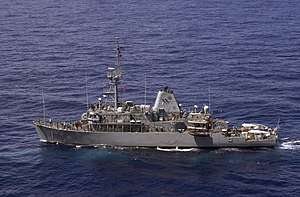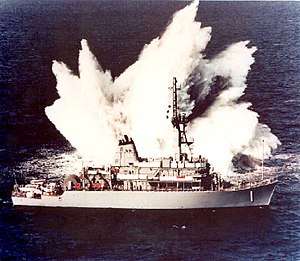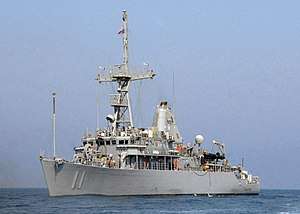Avenger-class mine countermeasures ship
Avenger-class mine countermeasures ships are a class of 14 ships constructed for the United States Navy from 1987 to 1994, designed to clear mines from vital waterways. The ships have the hull designator MCM.
 The USS Avenger (MCM-1) underway in Hawaiian waters in July 2004. | |
| Class overview | |
|---|---|
| Builders: |
|
| Preceded by: | Ability-class minesweeper |
| Succeeded by: | Littoral combat ship |
| In commission: | 1987 |
| Completed: | 14 |
| Active: | 11 |
| Lost: | 1 |
| Retired: | 2 |
| General characteristics | |
| Type: | Mine countermeasures ship |
| Displacement: | 1,312 tons |
| Length: | 224 ft (68 m) |
| Beam: | 39 ft (12 m) |
| Draft: | 15 ft (4.6 m) |
| Propulsion: |
|
| Speed: | 14 knots (26 km/h; 16 mph) |
| Complement: | 8 officers, 76 enlisted |
| Armament: |
|
History
Background
In the early 1980s, the U.S. Navy began development of a new mine countermeasures (MCM) force, which included two new classes of ships and minesweeping helicopters. The vital importance of a state-of-the-art mine countermeasures force was strongly underscored in the Persian Gulf during the eight years of the Iran–Iraq War, and in Operations Desert Shield and Desert Storm in 1990 and 1991 when Avenger and Guardian conducted MCM operations.
Avenger-class ships are designed as mine hunter-killers capable of finding, classifying, and destroying moored and bottom mines. The last three MCM ships were purchased in 1990, bringing the total to 14 fully deployable, oceangoing Avenger-class ships. These ships use sonar and video systems, cable cutters and a mine-detonating device that can be released and detonated by remote control. They are also capable of conventional sweeping measures.
Operations
As of 2012, eight Avengers were forward-based: four at Sasebo, Japan with standing crews, and four at Manama, Bahrain, with ten ships' companies on rotational deployments.[1] In March 2012, the USN announced plans to deploy another four MCMs to Bahrain to counter potential Iranian threats to mine the Strait of Hormuz reflecting increasing tensions between the United States and Iran over the latter's nuclear program.[1]
Design
Hull

The hulls of the Avenger-class ships are constructed of wood with an external coating of fiberglass. The wood used is oak, Douglas fir and Nootka Cypress because of their flexibility, strength and low weight. This construction allows the hull to withstand a nearby blast from a mine, and also gives the ship a low magnetic signature.
Mine countermeasures systems
The ships use AN/SLQ-48 remotely operated mine disposal system supplied by Alliant Techsystems (ATK) and the EX116 Mod 0 remotely operated vehicle (ROV) mine neutralization system supplied by ATK and Raytheon. The AN/SLQ-48 detects, locates, classifies, and neutralizes moored mines and mines resting on the seabed. The vehicle uses high-frequency, high-resolution sonar, low light level television (LLLTV), cable cutters, and explosive charges to detect and dispose of mines, while remaining tethered to the vessel by a 1,070 metres (3,510 ft) cable and under control of the vessel.
The ATK/Raytheon ROV is a similar system, but has a 1,500 metres (4,900 ft) tether cable, and also carries cable cutters for dealing with tethered or moored mines, and explosive charges to detonate the mines.
Sensor systems
The ships employ the AN/SQQ-32 advanced minehunting and classification sonar from Raytheon[1] and Thales Underwater Systems (formerly Thomson Marconi Sonar). The system has two sonars fitted in a small submersible pod towed under the ship. When not deployed the submersible is housed in a trunk below the deck of the ship. The sonars are a Raytheon search and detection sonar and a Thales high-resolution, high-frequency, target-classification sonar. The deployment and retrieval system for the submersible was designed by the Charles Stark Draper Laboratory in Massachusetts.
The Avenger class employ the AN/SPS-55 surface-search and navigation radar supplied by Cardion, Inc. of New York. The ships have been equipped with CMC Electronics LN66 or Raytheon AN/SPS-66 navigation radars, but are slated to be upgraded with the AN/SPS-73.
Propulsion
The Avenger-class ships are equipped with four Waukesha-Pearce diesel engines (MCM 1 and 2) or Isotta-Fraschini ID 36SS6V diesel engines (remainder), which are designed to have very low magnetic and acoustic signatures. Each engine develops 600 horsepower (447.4 kW) (combined 1.79 MW) sustained power, providing a cruising speed of 14 knots (26 km/h; 16 mph) with controllable pitch propellers. For stationkeeping the ship uses two Hansome electric motors rated at 294 kW. Precision maneuvering capability is provided by a 257 kW Omnithruster hydrojet (powered by Solar (Caterpillar Inc) Magnetic Marine Gas Turbine Generator).[2][3]
Ships
| Ship | Hull no. | Commissioned | Decommissioned | Builder | Home port | NVR Page |
|---|---|---|---|---|---|---|
| Avenger | MCM-1 | 12 September 1987 | 30 September 2014 | Peterson Shipbuilders | MCM01 | |
| Defender | MCM-2 | 30 September 1989 | 1 October 2014 | Marinette Marine | MCM02 | |
| Sentry | MCM-3 | 2 September 1989 | Peterson Shipbuilders | Manama, Bahrain | MCM03 | |
| Champion | MCM-4 | 8 February 1991 | Marinette Marine | San Diego, California | MCM04 | |
| Guardian | MCM-5 | 16 December 1989 | 15 February 2013[4] | Peterson Shipbuilders | MCM05 | |
| Devastator | MCM-6 | 6 October 1990 | Peterson Shipbuilders | Manama, Bahrain | MCM06 | |
| Patriot | MCM-7 | 18 October 1991 | Marinette Marine | Sasebo, Japan | MCM07 | |
| Scout | MCM-8 | 15 December 1990 | Peterson Shipbuilders | San Diego, California | MCM08 | |
| Pioneer | MCM-9 | 7 December 1992 | Peterson Shipbuilders | Sasebo, Japan | MCM09 | |
| Warrior | MCM-10 | 7 April 1993 | Peterson Shipbuilders | Sasebo, Japan | MCM10 | |
| Gladiator | MCM-11 | 18 September 1993 | Peterson Shipbuilders | Manama, Bahrain | MCM11 | |
| Ardent | MCM-12 | 18 February 1994 | Peterson Shipbuilders | San Diego, California | MCM12 | |
| Dextrous | MCM-13 | 9 July 1994 | Peterson Shipbuilders | Manama, Bahrain | MCM13 | |
| Chief | MCM-14 | 5 November 1994 | Peterson Shipbuilders | Sasebo, Japan | MCM14 |
Gallery
%3B11120302.jpg) USS Sentry and USS Kingfisher
USS Sentry and USS Kingfisher USS Guardian
USS Guardian USS Gladiator in the Persian Gulf
USS Gladiator in the Persian Gulf
See also
- List of mine warfare vessels of the United States Navy
- Osprey-class coastal minehunter - smaller vessels formerly in service with the USN
- Sandown-class minehunter - British contemporary
- Tripartite-class minehunter - numerous 1980s class in service in many European countries
References
Notes
- Tringham, Kate (16 March 2012). "US to double the number of minesweepers in the Persian Gulf". Jane's Navy International. Jane's Information Group.
- "DIESEL POWER REVIEW - Magazines". magazines.marinelink.com.
- "Avenger Class Navy Mine Hunters - Diesel Power Magazine". 1 June 2012.
- Guardian grounded on Tubbataha Reef on the night of 17 January 2013. Removing the ship intact off the reef proved impossible, so it was chainsawed into four pieces lifted off by crane, scrapping her.
Sources
- United States Navy Fact File: Mine Countermeasures Ships - MCM
- Globalsecurity.org MCM-1 Avenger Mine Countermeasures Ships
- Globalsecurity.org MCM-1 Avenger Mine Countermeasures Ships
- Naval-Technology.com: Avenger Class Mine Countermeasures Vessel
- Federation of American Scientists: MCM-1 Avenger Mine Countermeasures Ships
- This article includes information collected from the Naval Vessel Register, which, as a U.S. government publication, is in the public domain. The entry can be found here.